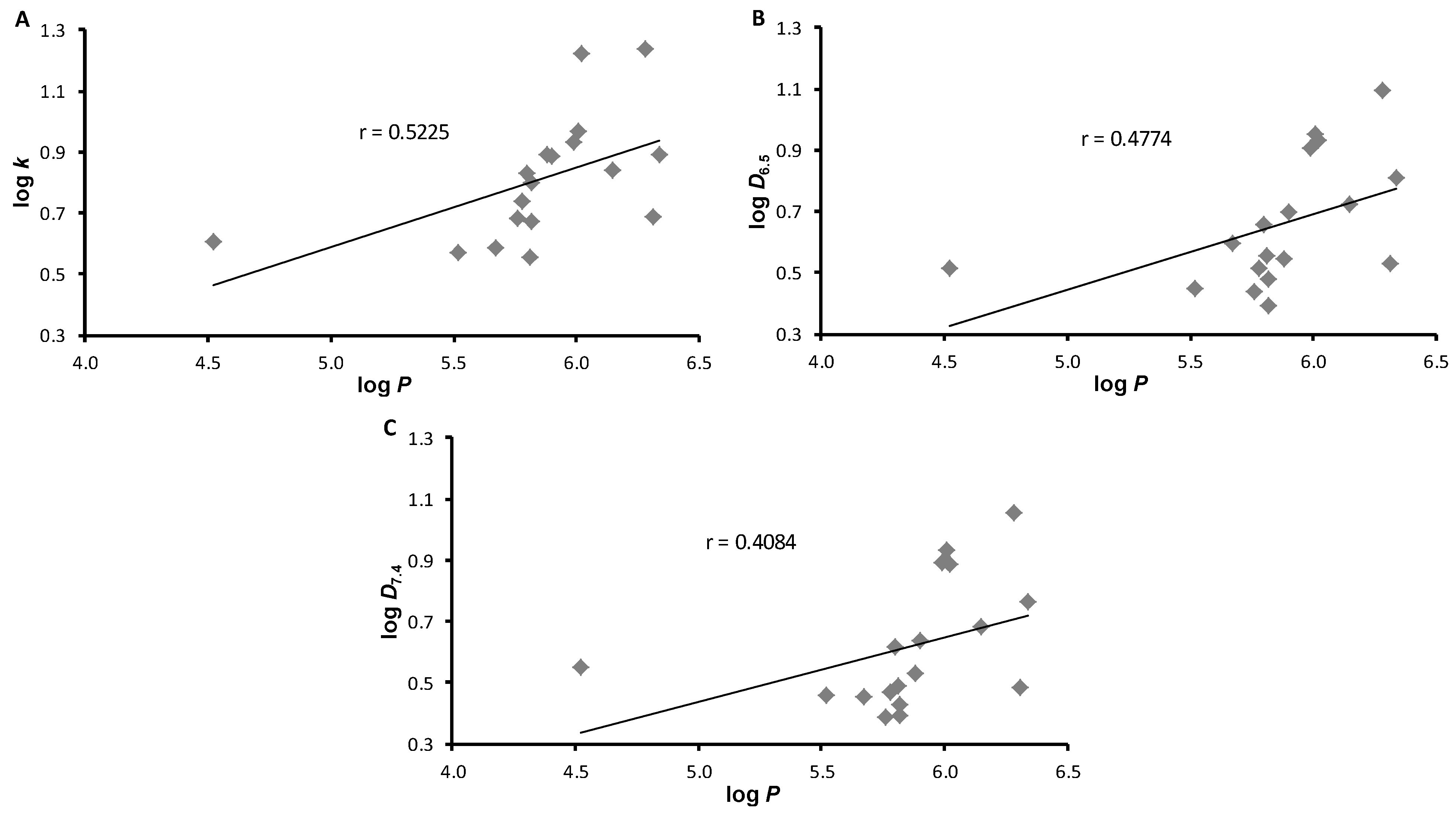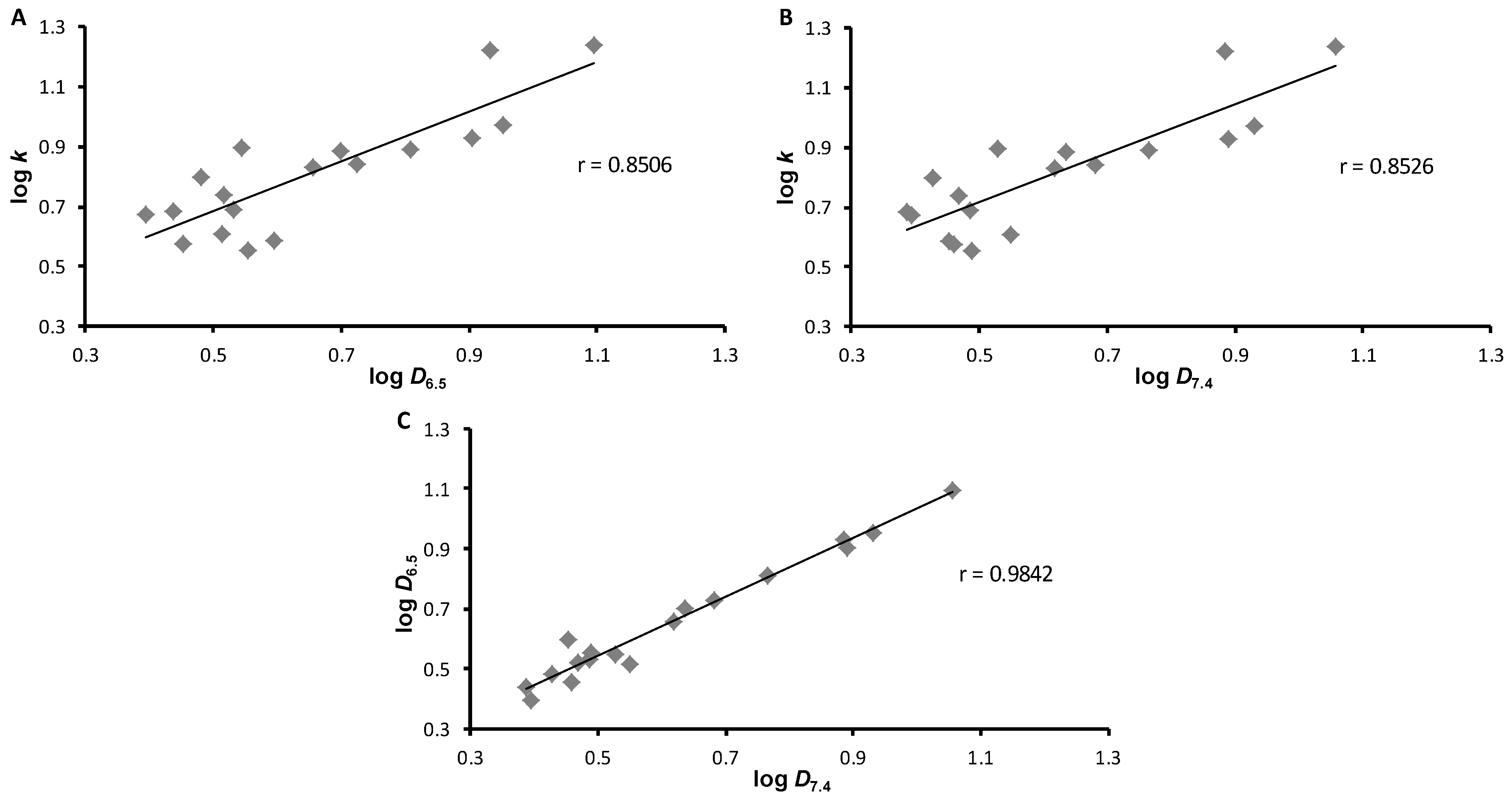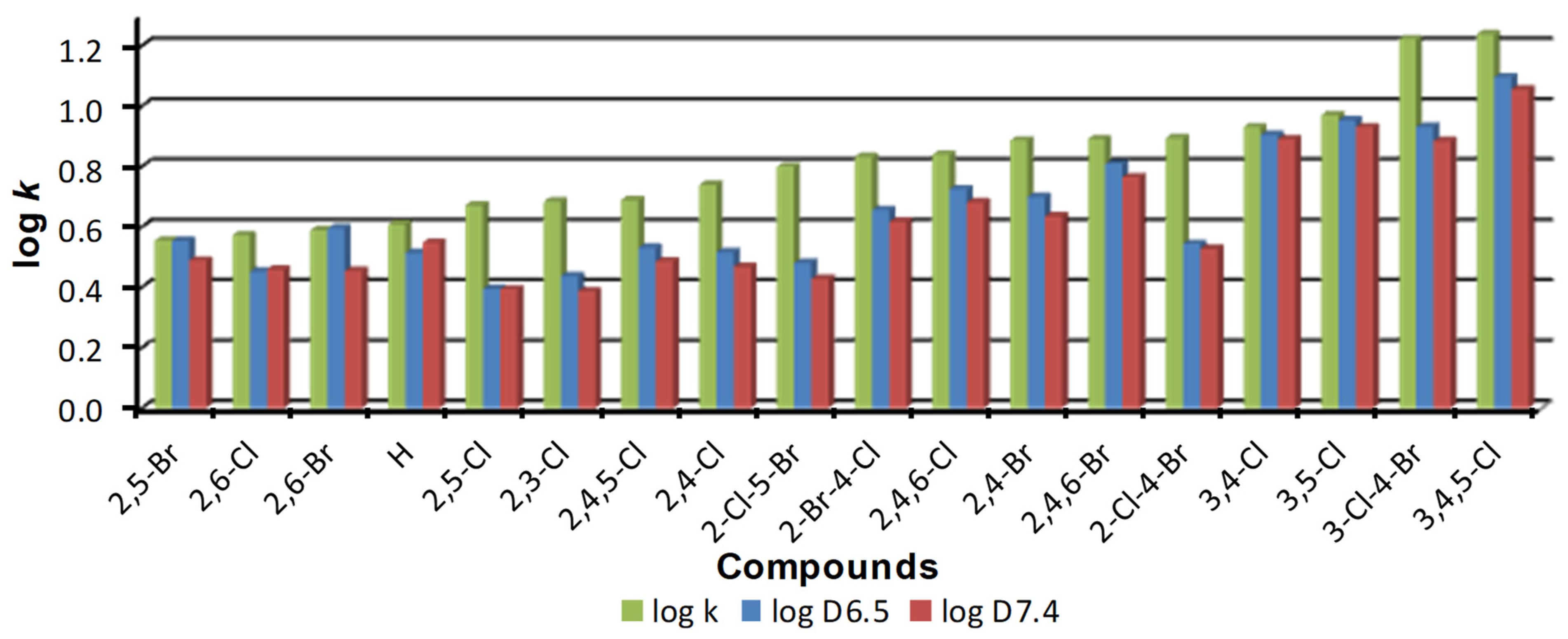Hydro-Lipophilic Properties of Chlorinated and Brominated 1-Hydroxynaphthalene-2-Carboxanilides †
Abstract
1. Introduction
2. Results and Discussion
3. Experimental Section
3.1. Synthesis
3.2. Lipophilicity Determination by HPLC
Author Contributions
Funding
Institutional Review Board Statement
Informed Consent Statement
Data Availability Statement
Conflicts of Interest
References
- Wu, K.; Karapetyan, E.; Schloss, J.; Vadgama, J.; Wu, Y. Advancements in small molecule drug design: A structural perspective. Drug Discov. Today 2023, 28, 103730. [Google Scholar] [CrossRef] [PubMed]
- Pennington, L.D.; Hesse, M.J.; Koester, D.C.; McAtee, R.C.; Qunies, A.M.; Hu, D.X. Property-based drug design merits a Nobel prize. J. Med. Chem. 2024, 67, 11452–11458. [Google Scholar] [PubMed]
- Kerns, E.H.; Di, L. Drug-Like Properties: Concepts. Structure Design and Methods: From ADME to Toxicity Optimization; Academic Press: San Diego, CA, USA, 2008. [Google Scholar]
- Pliska, V.; Testa, B.; van der Waterbeemd, H. Lipophilicity in Drug Action and Toxicology; Wiley-VCH: Weinheim, Germany, 1996. [Google Scholar]
- Giaginis, C.; Tsopelas, F.; Tsantili-Kakoulidou, A. The impact of lipophilicity in drug discovery: Rapid measurements by means of reversed-phase HPLC. Methods Mol. Biol. 2018, 1824, 217–228. [Google Scholar] [PubMed]
- Rutkowska, E.; Pajak, K.; Jozwiak, K. Lipophilicity – methods of determination and its role in medicinal chemistry. Acta Pol. Pharm. 2013, 70, 3–18. [Google Scholar] [PubMed]
- Tsopelas, F.; Giaginis, C.; Tsantili-Kakoulidou, A. Lipophilicity and biomimetic properties to support drug discovery. Expert Opin. Drug Discov. 2017, 12, 885–896. [Google Scholar] [CrossRef] [PubMed]
- Kempinska, D.; Chmiel, T.; Kot-Wasik, A.; Mroz, A.; Mazerska, Z.; Namiesnik, J. State of the art and prospects of methods for determination of lipophilicity of chemical compounds. Trends Anal. Chem. 2019, 113, 54–73. [Google Scholar] [CrossRef]
- Soares, J.X.; Santos, A.; Fernandes, C.; Pinto, M.M.M. Liquid chromatography on the different methods for the determination of lipophilicity: An essential analytical tool in medicinal chemistry. Chemosensors 2022, 10, 340. [Google Scholar] [CrossRef]
- Gonec, T.; Kos, J.; Zadrazilova, I.; Pesko, M.; Keltosova, S.; Tengler, J.; Bobal, P.; Kollar, P.; Cizek, A.; Kralova, K.; et al. Antimycobacterial and herbicidal activity of ring-substituted 1-hydroxynaphthalene-2-carboxanilides. Bioorg. Med. Chem. 2013, 21, 6531–6541. [Google Scholar] [PubMed]
- Gonec, T.; Kos, J.; Pesko, M.; Dohanosova, J.; Oravec, M.; Liptaj, T.; Kralova, K.; Jampilek, J. Halogenated 1-hydroxynaphthalene-2-carboxanilides affecting photosynthetic electron transport in photosystem II. Molecules 2017, 22, 1709. [Google Scholar] [CrossRef] [PubMed]
- Spaczynska, E.; Mrozek-Wilczkiewicz, A.; Malarz, K.; Kos, J.; Gonec, T.; Oravec, M.; Gawecki, R.; Bak, A.; Dohanosova, J.; Kapustikova, I.; et al. Design and synthesis of anticancer 1-hydroxynaphthalene-2-carboxanilides with a p53 independent mechanism of action. Sci. Rep. 2019, 9, 6387. [Google Scholar] [CrossRef] [PubMed]




 | |||||||
|---|---|---|---|---|---|---|---|
| Comp. | R | log k | log D6.5 | log D7.4 | log P 1 | log P 2 | Clog P 2 |
| 1 | H | 0.6084 | 0.5139 | 0.5487 | 4.52 | 3.45 | 4.44620 |
| 2 | 2,3-Cl | 0.6838 | 0.4371 | 0.3870 | 5.76 | 4.56 | 5.24996 |
| 3 | 2,4-Cl | 0.7387 | 0.5168 | 0.4680 | 5.78 | 4.56 | 5.36996 |
| 4 | 2,5-Cl | 0.6717 | 0.3949 | 0.3938 | 5.82 | 4.56 | 5.36996 |
| 5 | 2,6-Cl | 0.5729 | 0.4516 | 0.4594 | 5.52 | 4.56 | 4.51996 |
| 6 | 3,4-Cl | 0.9304 | 0.9048 | 0.8909 | 5.99 | 4.56 | 6.09996 |
| 7 | 3,5-Cl | 0.9704 | 0.9531 | 0.9306 | 6.01 | 4.56 | 6.21996 |
| 8 | 2,4,5-Cl | 0.6894 | 0.5314 | 0.4864 | 6.31 | 5.12 | 5.99452 |
| 9 | 2,4,6-Cl | 0.8398 | 0.7254 | 0.6825 | 6.15 | 5.12 | 5.26452 |
| 10 | 3,4,5-Cl | 1.2387 | 1.0960 | 1.0561 | 6.28 | 5.12 | 6.72452 |
| 11 | 2,4-Br | 0.8863 | 0.6991 | 0.6353 | 5.9 | 5.10 | 5.63996 |
| 12 | 2,5-Br | 0.5551 | 0.5535 | 0.4888 | 5.81 | 5.10 | 5.63996 |
| 13 | 2,6-Br | 0.5887 | 0.5951 | 0.4541 | 5.67 | 5.10 | 4.75996 |
| 14 | 2,4,6-Br | 0.8911 | 0.8090 | 0.7648 | 6.34 | 5.93 | 5.65452 |
| 15 | 2-Cl-4-Br | 0.8936 | 0.5442 | 0.5282 | 5.88 | 4.83 | 5.51996 |
| 16 | 2-Cl-5-Br | 0.8004 | 0.4803 | 0.4275 | 5.82 | 4.83 | 5.51996 |
| 17 | 3-Cl-4-Br | 1.2223 | 0.9317 | 0.8847 | 6.02 | 4.83 | 6.22996 |
| 18 | 2-Br-4-Cl | 0.8320 | 0.6566 | 0.6174 | 5.80 | 4.83 | 5.48996 |
Disclaimer/Publisher’s Note: The statements, opinions and data contained in all publications are solely those of the individual author(s) and contributor(s) and not of MDPI and/or the editor(s). MDPI and/or the editor(s) disclaim responsibility for any injury to people or property resulting from any ideas, methods, instructions or products referred to in the content. |
© 2024 by the authors. Licensee MDPI, Basel, Switzerland. This article is an open access article distributed under the terms and conditions of the Creative Commons Attribution (CC BY) license (https://creativecommons.org/licenses/by/4.0/).
Share and Cite
Vrablova, L.; Gonec, T.; Jampilek, J. Hydro-Lipophilic Properties of Chlorinated and Brominated 1-Hydroxynaphthalene-2-Carboxanilides. Chem. Proc. 2024, 16, 26. https://doi.org/10.3390/ecsoc-28-20151
Vrablova L, Gonec T, Jampilek J. Hydro-Lipophilic Properties of Chlorinated and Brominated 1-Hydroxynaphthalene-2-Carboxanilides. Chemistry Proceedings. 2024; 16(1):26. https://doi.org/10.3390/ecsoc-28-20151
Chicago/Turabian StyleVrablova, Lucia, Tomas Gonec, and Josef Jampilek. 2024. "Hydro-Lipophilic Properties of Chlorinated and Brominated 1-Hydroxynaphthalene-2-Carboxanilides" Chemistry Proceedings 16, no. 1: 26. https://doi.org/10.3390/ecsoc-28-20151
APA StyleVrablova, L., Gonec, T., & Jampilek, J. (2024). Hydro-Lipophilic Properties of Chlorinated and Brominated 1-Hydroxynaphthalene-2-Carboxanilides. Chemistry Proceedings, 16(1), 26. https://doi.org/10.3390/ecsoc-28-20151







